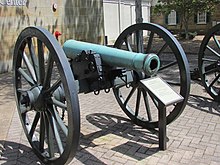| |
|---|---|
 A 6-pounder smoothbore gun of the type issued to the battery | |
| Active | c. September 7, 1862 to June 7, 1865 |
| Allegiance | Confederate States |
| Branch | Confederate States Army |
| Type | Artillery |
| Engagements | |
The 1st Missouri Field Battery was a field artillery battery that served in the Confederate States Army during the American Civil War. The battery was formed by Captain Westley F. Roberts in Arkansas in September 1862 as Roberts' Missouri Battery and was originally armed with two 12-pounder James rifles and two 6-pounder smoothbore guns. The unit fought in the Battle of Prairie Grove on December 7, as part of a Confederate offensive. Roberts' Battery withdrew after the battle and transferred to Little Rock, Arkansas, where Roberts resigned and was replaced by Lieutenant Samuel T. Ruffner.
During the middle of 1863, the unit, as Ruffner's Missouri Battery, was part of a force sent to the Mississippi River under the command of Colonel John Bullock Clark Jr., with the intent of harassing Union shipping. Clark's force was eventually recalled to Little Rock, which was being threatened by the Union Army of Arkansas under Major General Frederick Steele. The Confederates abandoned Little Rock on September 10, and Ruffner's Battery saw action during the retreat as part of the rear guard. After the retreat from Little Rock, Ruffner's Battery was temporarily assigned to Brigadier General John S. Marmaduke's cavalry division. The battery accompanied Marmaduke in an expedition against the Union garrison of Pine Bluff, Arkansas, seeing action at the Battle of Pine Bluff on October 25.
The unit's assignment to Marmaduke's division ended in December, after which it received a new set of cannons: two 10-pounder Parrott rifles and two 12-pounder howitzers. In early 1864, it became part of Brigadier General Mosby M. Parsons's division, which was ordered into Louisiana in April to counter a Union thrust up the Red River. While Parsons's infantry fought at the Battle of Pleasant Hill on April 9, Ruffner's Battery served in a reserve role and was not engaged. The Union troops present at Pleasant Hill continued to retreat back down the river, so Parsons was returned to Arkansas to move against Steele's Camden expedition. Supply issues forced Steele to retreat from Camden, Arkansas, and the Union troops were pursued to the Saline River. On April 30, the Confederates caught up with Steele at the river crossing and attacked, starting the Battle of Jenkins' Ferry. Ruffner's Battery, along with Lesueur's Missouri Battery, supported an infantry assault, but moved to an exposed position in the process. A Union counterattack captured several of Ruffner's Battery's cannons and Steele's men escaped across the river that night. The battery was then rearmed with four 6-pounder smoothbores.
In November 1864, the unit was given the official designation of the 1st Missouri Field Battery. It spent the remainder of the war in Louisiana and Arkansas and was paroled on June 7, 1865, at Alexandria, Louisiana, after General Edmund Kirby Smith signed surrender terms for the Confederate Trans-Mississippi Department on June 2.
